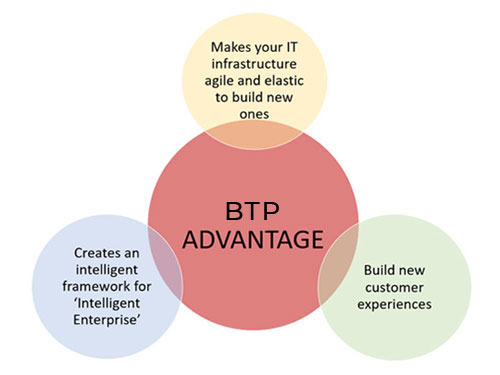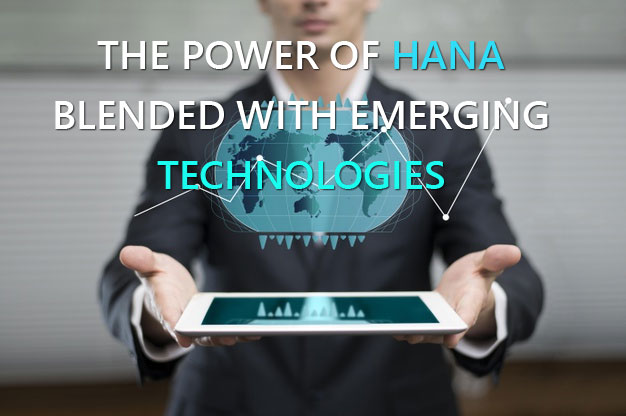SAP Business Technology Platform (BTP) – The Business Problem Solver
By Sabahat Kazi, Global Head, ERP, Nihilent
Robin Rastogi Senior Vice President, Nihilent Australia
The SAP Business Technology Platform (BTP) is a Platform as a Service (PaaS) offering for enterprises across industries. The platform can be leveraged for creating new applications, scale-up existing applications, that are hosted in a secure on-demand cloud environment, managed by SAP. SAP’s BTP is an ideal platform for enterprises to integrate data and business processes. Moreover, Nihilent’s SAP Practice has rich experience in large enterprise transformation engagements.
NIHILENT’S SAP PRACTICE- THE BIG PICTURE

WHY BTP?
Before we deep dive into the deliverables of BTP, let us try and decode the multiple challenges facing IT organizations today. One of the biggest problems confronting enterprise IT organizations today is heterogeneity. In any SAP landscape, you will find a lot of boxes, a lot of linkages of interfaces between systems, and the use of different technologies.

Multiple apps make even your SAP ERP bloated if it’s not managed intelligently. Beyond this, the other big challenge is due to the rapid changes in the way consumers consume technology has given rise to the digital age. If you are still using legacy SAP, then you will not be able to address the user demands and be relevant. In other words, we need to bring in the consumer-grade experience into our work life. Another challenge is your ability to embrace emerging technologies to tame disruption and being innovative and creative.

The case in the point is, we need a nimble IT infrastructure that is well-tuned to address the challenges posed by the market and the consumer demands. Here is where BTP makes its entry and unbundles the complexities. We would say that BTP is the best platform for SAP customers because it has ready integrations with your other SAP systems.
BTP MAKES FOR AN INTELLIGENT ENTERPRISE
As we all know, SAP is aggressively evangelizing the concept of ‘Intelligent Enterprise’. What does it mean to the organizations?

For instance, on the one side, we have the operations, which is your typical core ERP system, or your planning systems covering your HR or finance, supply chain, procurement et al. This is the operational part. On the other side, we need to ensure how we can usher in greater customer experience with these operational systems – both internal and external stakeholders.
So, while the operations cover the what and the why part, which is knowing why things are happening. The more important is granulating the needs, wants, and aspirations of the customers. In other words, the operational systems have to be well-tuned to meet the demanding customer expectations and foster greater customer experience.
In this context, BTP is a key component of SAP’s Business Technology Platform (BTP) and acts as a fulcrum in creating a unified backbone that can usher in operational efficiencies as well as superior customer experience. For instance, using BTP, one can do application development, integration with other systems. You even have a HANA database available. So, if you want to perform, for example, predictive analytics, you can run it on that.

You have SAP Leonardo where you can harvest emerging technologies like IoT
While BTP is a platform as a service, there are different ways in which you can use it.
LEVERAGE BTP WITH A MULTI PRONGED APPROACH
BTP makes for rapidly scaling up your existing environment by giving you ample headroom to grow your application environment. What it means is, one, you can transition the existing apps to BTP and make the IT infrastructure agile and elastic to build new ones. The first approach hence is to create this extension path. The second, you can build new customer experiences. The final approach is creating an intelligent framework.

Now let’s look at BTP up close. If you break it up, the good news is, it supports multiple platforms from what used to be available only in SAP infrastructure in the past. From a data perspective, you have the in-memory HANA database, which is available in BTP. So, you can have massive amounts of data, and you can get response time as low as milliseconds out of it. Next is the technical services. Here you can leverage new and emerging technologies, like machine learning, blockchain, analytics, mobile portal development among others.

BTP also gives you the ability to create ‘Business Services’. Say, for instance, you need to calculate tax for a certain product, no need to build it from the scratch. These business services are already available. In this case, you can directly use it to calculate tax in any geography around the world. From a master data perspective, you have a common master data framework. You can use it across applications. Then, you also have an open Marketplace, where both SAP as well as partners are publishing connectors or APIs which you can use as per your needs.
So, with BTP, any type of application is integrated with any other system and you can extend your current solutions and have a user experience, which is consumer-grade. The point here is, with BTP you gain access to 65 plus services.
When we talk about extending the solutions, what it means is, you may already have ERP or S/4HANA or S/4HANA cloud. You can extend the capabilities because many times you have white spaces in the standard recipe solutions. Can you plug in those white spaces? Definitely.
Let us demonstrate with few use cases.
This is an example of a custom workflow we built. This is a very typical problem people have. You will have the SAP material master. A lot of people need to co-operate, collaborate, and fill in a lot of information. Many companies resort to either some external tools or they have an excel sheet that flows via mail. Each one, each department, for example, supply chain, quality, sales, will keep on filling the required fields. And when it is filled up, somebody needs to validate, and then upload it into the system to create the material master.
So, there is, an easier way to do this application. With BTP, what it does is, it creates a workflow once you have initiated the creation of the master. It goes in a certain flow, from one department to the next each department fills up the required information. There are validations in terms of dropdowns, which are available. So, you select the right drop-down. And ultimately, once it is all approved, it creates the master in the background in SAP.

The second use case is to build a new application altogether, an application that differentiates instead of searching for the right language, the right services, acquisition, conversion, unit of measure conversions, you have all that ready as business services. Use the ready connectivity option available in SAP. Another advantage when you are creating those new applications, if we were doing it within the core SAP system itself, we may not be able to leverage the emerging technologies. But if you build it on the SAP cloud platform, you can leverage those emerging techs as well.
Here is an example of a solution we have built for B2B and to customer kind of business. You have distributors who ultimately may supply to a stockist or may supply directly to the retailers or the stores. What we are trying to do is we are trying to bring the secondary sales data, which your channel partner is selling to the next level in a supply chain. So, they can do their purchase from you. When they create a purchase order it translates into a sales order in your system. And, similarly, they can also directly sell to their customers or the stores. Even that data is made available to you in real-time. There is no time lost in converting the purchase order of your dealer distributor into a sales order in your system. It is in real-time. So, this is a solution we have built on the SAP cloud platform, it’s called iDeal.
Another example of build, for example, is our iCSR solution. This caters to managing CSR spends. Corporate Social Responsibility (CSR) is a broad concept that can take many forms depending on the organization and the industry. It is a self-regulating model that helps an organization to be socially accountable—to itself, its stakeholders, and the public. Through CSR programs, philanthropy, and volunteering efforts, businesses can be socially responsible while boosting their brand equity. As the CSR spends are increasing and compliance requirements becoming more stringent, companies must ensure that the funds, as well as efforts, are well spent. A well meshed and seamless CSR enablement is vital. Here is where iCSR comes into play.
iCSR is a cloud-based comprehensive solution to manage and track all your CSR related activity including compliances. iCSR can be accessed from anywhere at any time through Desktop or Mobile devices.
The third type of use case is related to the new user experience. This is an example of bringing multiple channels into one single system by leveraging SAP Fiori. The fourth use case a very important use case in fact and is related to integrating multiple systems. Organizations not just use one siloed SAP system, they would be running other solutions from SAP as well as non-SAP solutions. So, the integration trait within the BTP provides you ready APIs, ready connectors with multiple systems, and in fact, there are more than 150 different types of connectors which are available. You can just subscribe to them and start using them. The idea of an intelligent enterprise is where you have seamless processes, irrespective of which application you are using in the background.
We have covered four different types of use cases: Extending, Building, User Experience, and Integration.
At the end of the day, the key takeaway message is, by smartly leveraging BTP, it can jump-start your digital transformation initiatives and makes you relevant to market demands.
Most Read
May 28, 2019
Driving Operational Excellence Through Design Thinking
February 11, 2020
The Art of Data Science
June 12, 2019
Financial Inclusion through Digital Diversification





